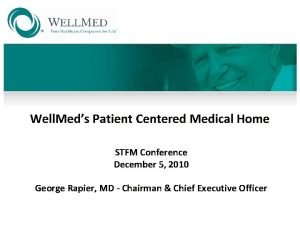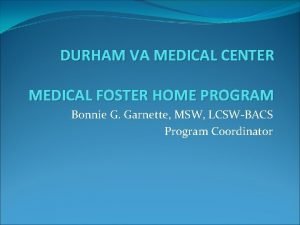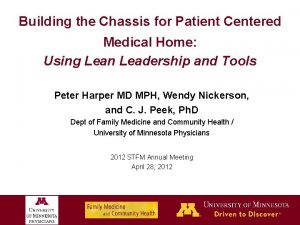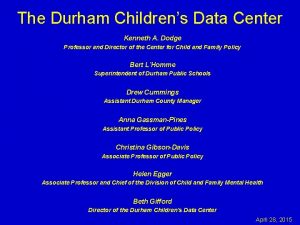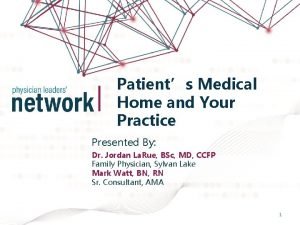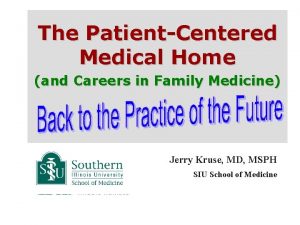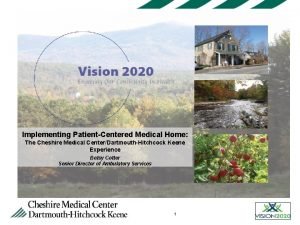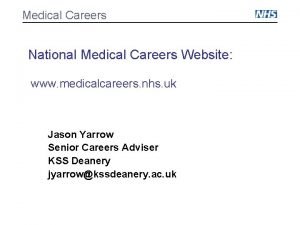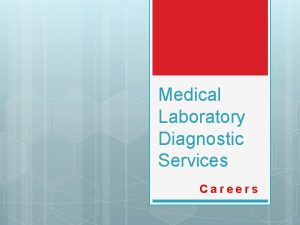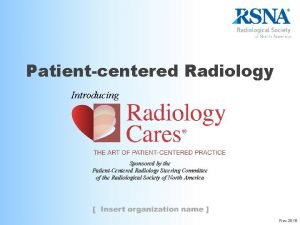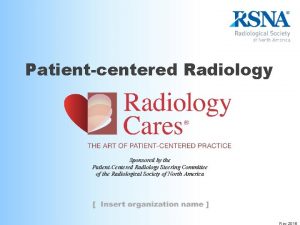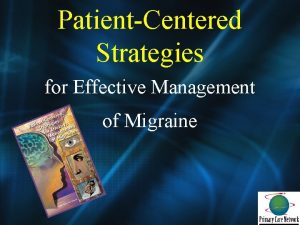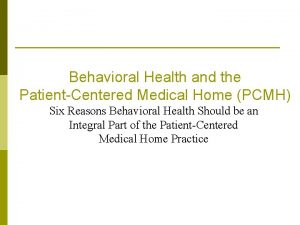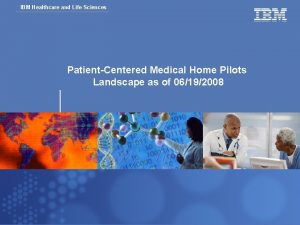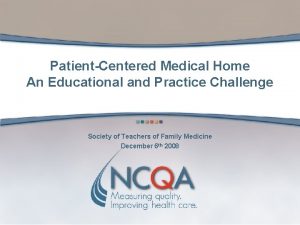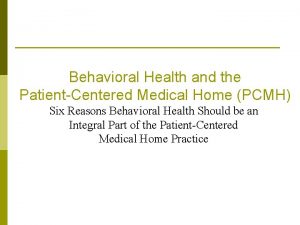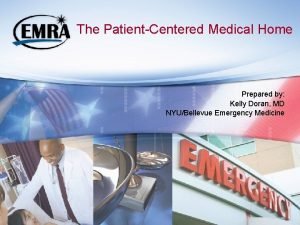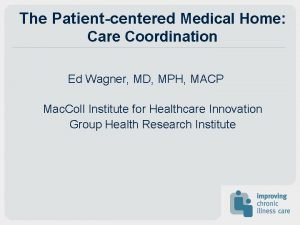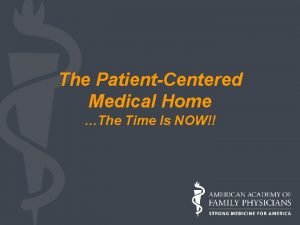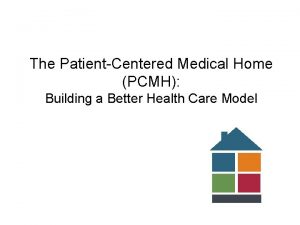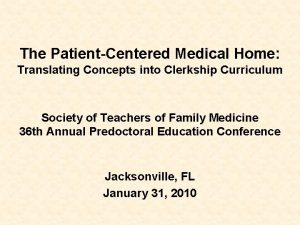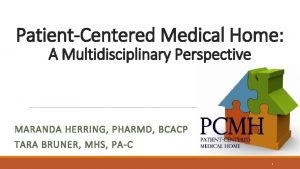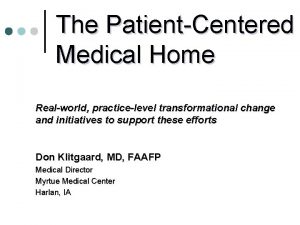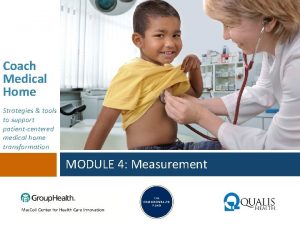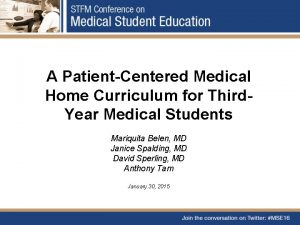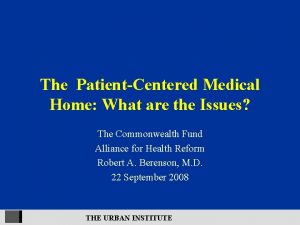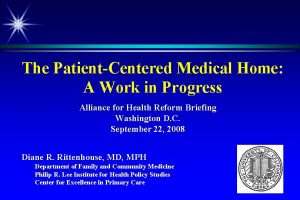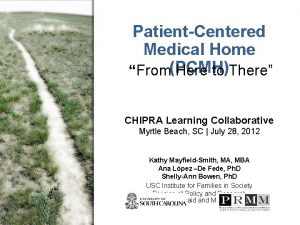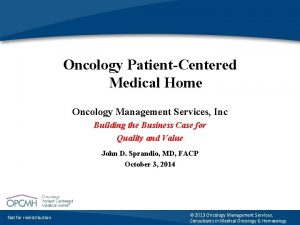The PatientCentered Medical Home and Careers in Family










































- Slides: 42

The Patient-Centered Medical Home (and Careers in Family Medicine) Jerry Kruse, MD, MSPH SIU School of Medicine

Family & Community Medicine Preceptors: Giving Back to the Profession Board-Certified Family Physicians from across the State of Illinois donate their time to serve as preceptors and mentors for medical students and resident physicians. The 6 -week FCM clerkship in Year 3 is the only curricular requirement for the SIU medical students to participate in a block experience in a Patient. Centered Medical Home FCM Preceptor Sites

The Patient-Centered Medical Home: History • 1967 - Pediatrics: “Medical Home” • 2002 - Family Medicine: “Personal Medical Home” • 2006 - Internal Medicine: “Advanced Medical Home” • 2004, 2005 - Evidence-based Characteristics Defined Characteristics of primary care practices that improve outcomes and lower costs published by Starfield and colleagues • 2006, Sept 28 - Broad Legislative Support Rep. Nathan Deal, Chair, House Energy & Commerce Subcommittee on Health, noted broad legislative support for Medical Home concept • 2007, Feb - AOA, AAFP, ACP, AAP publish “Joint Principles of the Patient-Centered Medical Home” http: //www. medicalhomeinfo. org/Joint%20 Statement. pdf

Health Care Spending per capita ($US PPP) Purchasing Power Parity 2006 OECD Data United States Germany Source: K. Davis, C. Schoen, S. Guterman, T. Shih, S. C. Schoenbaum, and I. Weinbaum, Slowing the Growth of U. S. Health Care Expenditures: What Are the Options? The Commonwealth Fund, January 2007, updated with 2007 OECD data $6714 $3371

Breast Cancer Screening Percent 80 70 60 Percentage of Women age 40 or over who had Mammography within the past 2 years (1987 -2005) 50 40 Source: CDC, National Center for Health Statistics, National Health Interview Survey 30 (Age Adjusted using the NCHS 2000 Standard Population) 1987 1989 1991 1993 1995 1997 Year 1999 2001 2003 2005 Reported in: Breen, N. Cancer, June 15, 2007; vol 109

Percent Cervical Cancer Screening 80 78 76 Percentage of Women ages 18 to 65 who had a Pap Test within the past 3 years (19872005) 74 72 Source: CDC, National Center for Health Statistics, National Health Interview Survey 70 (Age Adjusted using the NCHS 2000 Standard Population) 1987 1989 1991 1993 1995 1997 1999 2001 2003 2005 Year

Infant Mortality Rates 2000 and 2008 From: CIA – The World Factbook 8 Infant Mort. Rate 7 Deaths per 1000 live births 5 In 2002, the US infant mortality rate rose for the first time in 40 years. The US infant mortality rate now exceeds that of Cuba 7. 5 6. 8 6. 3 2000 2008 5. 9 6 4. 8 4. 5 4. 0 4 3. 3 3. 9 3. 5 2. 8 3 3. 7 2. 3 2 1 USA % Improvement 2000 -2008 7% Cuba 21% Germany France Japan Sweden Singapore 20% 22% 28% 23% 31% https: //www. cia. gov/library/publications/the-world-factbook/rankorder/2091 rank. html http: //comdinet. com/comdi/templates/factbook/fields/infant_mortality_rate. html

USA TODAY · MONDAY FEBRUARY 16, 2009 · 5 D

1990 – US childhood immunization rate lowest in the industrialized world 80 -85% 1990 – Invasive Hib disease strikes 1 in 300 children annually, and is the leading cause of death and permanent disability due to infectious disease 1991 – Conjugate Hib vaccine developed 1992 – Childhood Immunization Initiative enacted at a cost of $30 per birth 1995 – Effective immunization rates have reached 95%, equal to other rich nations 1998 – Invasive Hemophilus Influenza type B rates fall to essentially zero 2004 – Invasive HIB cases begin to rise 2008 – Invasive HIB disease reported at alarming rates, likely due to the United States’ crumbling primary care and public health infrastructure USA TODAY · MONDAY FEBRUARY 16, 2009 · 5 D

Measuring the Health of Nations: Deaths from Treatable Conditions E. Nolte, et al: Measuring the Health of Nations: Updating an Earlier Analysis, Health Affairs, 2008, 27(1): 58– 71 Corroboration: US ranks 37 th in 2000 WHO Rankings World Health Organization, The World Health Report 2000, Health Systems Improving Performance Geneva, Switzerland http: //www. who. int/whr/2000/en/index. html

US Healthcare: Best in the World? US ranking compared to 13 rich nations: Low Birth Weight percentage Neonatal and Infant mortality Potential Years of Life Lost Life Expectancy at 1 year Life Expectancy at 15 years Life Expectancy at 40 years Life Expectancy at 65 years Life Expectancy at 80 years Age-adjusted mortality Rank 13 th 12 th 11 th 10 th 7 th 3 rd 10 th Babara Starfield, Journal of the American Medical Association, 2000; 284: 483 -5 Comparison of US data to Australia, Belgium, Canada, Denmark, Finland, France, Germany, Japan, Netherlands, Spain, Sweden, United Kingdom

Ratio of Full-Time Equivalent Members of the Tax-paying Workforce to the Number of Medicare Beneficiaries From 2010 to 2030 35% decline Ratio of Workers to Medicare Beneficiaries Year Source: David Walker, Comptroller General of the US, Government Accountability Office 2004 Annual Report of the Board of Trustees of the Federal Hospital Insurance and Federal Supplemental Medicare Insurance Trust Funds

The Patient-Centered Medical Home: The Evidence Johns Hopkins Bloomberg School of Public Health Examples: Starfield, Shi, Macinko. Contributions of Primary Care to Health Systems and Health: The Milbank Quarterly 83(3), 2005; 457 -502 Starfield & Shi. The Medical Home Access to Care, and Insurance, A Review of Evidence: Pediatrics, 2004; 113: 1493 -99 Dartmouth Center for Health Policy and Clinical Practice Formerly “The Center for Clinical Evaluative Sciences at Dartmouth”

Comprehensive Review of the Effectiveness of Primary Care Contribution of Primary Care to Health Systems and Health Barbara Starfield, Leiyu Shi and James Macinko Johns Hopkins University, New York University The Milbank Quarterly, Volume 83, No. 3, 2005 Pages 457 - 502

Institute of Medicine Definition of Primary Care “… (1) the provision of integrated, accessible health care services (2) by clinicians who are accountable for addressing a large majority of health care needs, (3) developing sustained partnerships with patients, and (4) practicing within the context of the family and community…” General Pediatrics: The Medical Home (1967) Family Medicine: The Personal Medical Home (2002) Internal Medicine: The Advanced Medical Home (2006) General Now: The Patient-Centered Medical Home (2007) Donaldson, IOM Report, Primary Care: America’s Health in a New Era, 1996 IOM Report, 1978

Improving Health Outcomes for Populations Primary Care prevents illness and death through the following four mechanisms: 1. Supply of primary care physicians: Ratio of generalist physicians to the total population 2. Supply of primary care physicians: Ratio of generalist physicians to all physicians 3. Relationship with a source of primary care Peds: Medical Home FP: Personal Medical Home GIM: Advanced Medical Home 4. Important features of the Health Care System Starfield, Shi, Macinko. The Milbank Quarterly 2005: 83(3); 457 -502 PCMH

Population-Based Health Outcomes, Equity and Cost In the modern, industrialized world, the nations and regions that place a relatively greater emphasis on public health, preventive medicine, and organized systems of first contact care with primary care physicians consistently have better health outcomes, more equitable systems, and lower costs.

Population-Based Health Outcomes, Equity and Cost • The nations and regions that emphasize these things consistently have better health outcomes, more equitable systems, and substantially lower costs. a. Public health and preventive medicine b. Usual sources of comprehensive care (Primary Care Physicians) c. First-contact care with effective systems of care (PCMH) • Health outcomes are optimized when 40 -50% of the physician workforce is made up of primary care physicians • Socioeconomic and racial disparities in healthcare outcomes are dramatically reduced when there is an appropriate primary care workforce

Health System and Policy Characteristics Associated With Improved Health Outcomes • Attempts to distribute health services equitably with respect to regional health care needs • Universal or near-universal financial assistance guaranteed by a publicly accountable body • Low or no co-pay for health services • Percentage of physicians who are generalists • Professional earnings of primary care physicians relative to other specialties Starfield, Shi, Macinko. The Milbank Quarterly 2005: 83(3); 457 -502

US 2005 -32% US entering residency classes – 2005, 2006 – 18% 2007 – 16% 2008, 2009 – 14%

The Cost and Quality of Healthcare Dartmouth Center for Evaluative Clinical Sciences Data Source: Medicare Data Base - 1995, 1999, 2003 State Medicare QIO Data - 2000, 2001 Unit of Care: State Method: Ranked the states using 24 recognized measures of health care quality, and compared quality to health care spending and the composition of the health care workforce Baicker K et al: Health Affairs, Apr. 7, 2004 p. 184 f Fisher ES et al: Ann Int Med, Feb 18, 2003 p. 273 f Jencks SF et al: JAMA, 2000; 284: 1670 -76 These 24 measures of health quality have been standardized by Steve Jencks and reported in 2000. They include both measures of inpatient and outpatient performance and measures of preventive medicine and disease treatment. Examples include appropriate screening for breast and cervical cancer, use of aspirin after MI, and use of warfarin for atrial fib.

This is an example of how the data are reported in the Baicker article. Each state is ranked by health care quality, and this is graphed against annual spending per Medicare beneficiary. There are 51 states because DC is included. The lower numbers reflect higher quality. As health care spending rises, quality declines significantly. Subsequent slides are based on the figures in the Baicker article, but leave out the points for each individual state.

75 th Percentile Quality $5200 per year 25 th Percentile Quality $6800 per year

25 th Percentile Quality 2. 5 per 10, 000 75 th Percentile Quality 3. 9 per 10, 000

25 th Percentile Spending 3. 8 per 10, 000 75 th Percentile Spending 2. 4 per 10, 000

The Patient-Centered Medical Home Characteristics of Practices of Personal Physicians Associated with Improved Health Outcomes and Equity, and with Lower Costs • First Contact Care The degree to which patients seek advice and care first at the practice of the personal physician, except for medical catastrophes • Patient-focused Care Over Time • Comprehensive Care • The degree to which the practice emphasizes patient-focused care, rather than disease-focused care; and longitudinal care, rather than episodic care The degree to which the personal physician provides a broad range of health services The degree of integration of care among health professionals and staff, both within the Patient-Centered Medical Home and with outside organizations and consultants, and the degree to which talents of all members of the team are used optimally. Family Orientation • Community Orientation • The degree to which medical services are provided to family members by the same personal physician degree to which the practice assesses the needs of the community, designs interventions, and measures outcomes Cultural Competence The degree to which the biopsychosocial model is employed and health beliefs are addressed Starfield, et al: The Milbank Quarterly 83(3), 2005; 457 -502 Starfield & Shi: Pediatrics, 2004; 113: 1493 -99 (Joint Principles) • Personal Physician • Physician Directed Medical Practice • Whole Person Orientation • Coordinated and Integrated Care Coordinated (Integrated) Care • AOA, AAFP, AAP and ACP Legislative Definition of the PCMH and Vision for the Office of the Future • Quality and Safety Measures Evident • EBM and Clinical Decision Support • Voluntary CQI Processes • Patient’s Expectation Met • HIT used appropriately • Voluntary Recognition Process • Enhanced Access • Appropriate Payment http: //www. medicalhomeinfo. org/Joint%20 Statement. pdf A critical evaluation of the scientific evidence for each of these characteristics: Rosenthal T: J Am Board Fam Med 2008; 21: 427 -440

Practice Characteristics Associated With Improved Health Outcomes and Lower Cost The Patient-Centered Medical Home • First Contact Care • Patient-focused Care over time • Comprehensive Care • Coordinated and Integrated Care • Family Orientation • Community Orientation • Cultural Competence Starfield & Shi: Pediatrics, 2004; 113: 1493 -99 Starfield et al: Milbank Quarterly 2005; 83: 457 -502

The Patient-Centered Medical Home: Radical Thinking Part 1 • Coordinated (Integrated) Care The degree of integration of care among health professionals and staff, both within the Patient. Centered Medical Home and with outside organizations and consultants, and the degree to which talents of all members of the team are used optimally.

The Patient-Centered Medical Home: Part 1 - Integrated Care - Personnel 1. Staff • • 2. Innovative Models Encouraged 40% Increase in staff to FTE physician ratio often needed Health Care Professionals • • • 3. Personal Primary Care Physicians (Longitudinal Comprehensivist Doctors) Family Physicians (General Internists, General Pediatricians) Mental Health (Social Workers and Counselors, e. g. , MSWs, LCPCs) Physician Assistants Nurse Practitioners (CFNP, CNM, Advance Practice Nurses) Pharmacists / Pharm. Ds Examples of Other Health Care Professionals, etc. • • 4. Physical Therapy, if large enough Clinical Nutritionist, if large enough Other Physicians • • Psychiatrist, if large enough General Surgeon, if critical access area (usually rural) Ob/Gyn, if large enough, and practices comprehensive, longitudinal maternal and child health (not a consultant) Hospitalists, if large enough for integrated primary care systems, and limit practice to patients and responsibilities of the PCMH

Two disciplines working hard but in isolation

Suddenly, a heated exchange took place between the king and the moat contractor Share a vision and communicate common goals

Set priorities

The Patient-Centered Medical Home Legislative Definition of AAFP, ACP, AAP & AOA • • • Personal Physician Directed Medical Practice Whole Person Orientation Coordinated and Integrated Care Quality and Safety Measures Evident • • • Evidence Based Medicine and Clinical Decision Support Voluntary Continuous Quality Improvement (CQI) Patient’s Expectation Met Health Information Technology used effectively Voluntary Recognition Process • Enhanced Access • Appropriate Payment A critical evaluation of the scientific evidence for each of these characteristics: Rosenthal T: J Am Board Fam Med 2008; 21: 427 -440

The Patient-Centered Medical Home: Part 2 The Power of Information Technology & Management Quality and Safety Measures • Evidence Based Medicine (EBM) and Clinical Decision Support • Voluntary Continuous Quality Improvement (CQI) • Patient’s Expectation Met • Health Information Technology and Electronic Health Records used effectively • Voluntary Recognition Process Health Information Exchange (HIE) “For Father’s Day, I’m giving my dad an hour of free tech support”

The PCMH Radical Thinking Part 3 Enhanced Access Inconvenience Store

Physician Payment Models Pay For Performance Per Member. Per Month Care Coordination Payment Fee for Service Quality Measurement and Reporting Based on Achievement in Quality Indicators of Medical Practice and Service Patient Centered Medical Home PCMH Based on a patient’s relationship with an effective source of primary care Relative Value Unit Scale Based on physician work ( physician's time, mental effort, technical skill, judgment, stress, education, and practice expense)

PCMH-PPC Proposed Content and Scoring Standard 1: Access and Communication A. Has written standards for patient access and patient communication** B. Uses data to show it meets its standards for patient access and communication** Pt 4 5 9 Standard 2: Patient Tracking and Registry Functions A. Uses data system for basic patient information (mostly non-clinical data) B. Has clinical data system with clinical data in searchable data fields C. Uses the clinical data system D. Uses paper or electronic-based charting tools to organize clinical information** E. Uses data to identify important diagnoses and conditions in practice** F. Generates lists of patients and reminds patients and clinicians of services needed (population management) Pt Standard 3: Care Management A. Adopts and implements evidence-based guidelines for three conditions ** B. Generates reminders about preventive services for clinicians C. Uses non-physician staff to manage patient care D. Conducts care management, including care plans, assessing progress, addressing barriers E. Coordinates care//follow-up for patients who receive care in inpatient and outpatient facilities Pt 2 Standard 5: Electronic Prescribing s A. Uses electronic system to write prescriptions B. Has electronic prescription writer with safety checks C. Has electronic prescription writer with cost checks Pts 3 3 Standard 6: Test Tracking s A. Tracks tests and identifies abnormal results systematically** B. Uses electronic systems to order and retrieve tests and flag duplicate tests Pts 7 3 3 21 3 4 3 5 2 4 13 Standard 8: Performance Reporting and Improvement A. Measures clinical and/or service performance by physician or across the practice** B. Survey of patients’ care experience C. Reports performance across the practice or by s physician ** D. Sets goals and takes action to improve performance E. Produces reports using standardized measures F. Transmits reports with standardized measures electronically to external entities Pts 3 Standard 9: Advanced Electronic Communications A. Availability of Interactive Website B. Electronic Patient Identification C. Electronic Care Management Support 5 Pt 6 PT 4 20 Standard 4: Patient Self-Management Support A. Assesses language preference and other communication barriers B. Actively supports patient self-management** 8 Standard 7: Referral Tracking A. Tracks referrals using paper-based or electronic system** 6 4 3 2 s ** Priority Elements 6 Physician Practice Connections and Patient Centered Medical Home 4 3 3 3 2 1 15 Pts 1 2 1 4

The Keys to Success of the PCMH Simplicity • Usual Source of Comprehensive, Longitudinal Care • Universal Access

The Keys to Success of the PCMH Simplicity • • • Usual Source of Comprehensive Care Universal Access Physicians, Healthcare Professionals and Staff want to practice in this setting – Do what it takes to: • Increase staff to physician ratio (by 40% ? ) • Increase primary care reimbursement (by 78% ? ) • All team members work at optimal levels • Patients want to come to the PCMH – Satisfy the needs of the patients

Career Paths in Family Medicine Practice Teaching Research Administration

Career Paths in Family Medicine: Advanced Training • Fellowships & Certificates of Added Qualification – – – Sports Medicine Geriatric Medicine Adolescent Medicine Occupational Medicine Preventive Medicine Aerospace Medicine Maternal Health (OB) Health Policy Research Master Educator Hospital Medicine • Master’s Degree Programs – Public Health (MPH, MSPH) – Business Administration (MBA) – Health Administration (MHA) – Medical Management (MMM) – Health Professional Education (MHPE)

 O/o medical term
O/o medical term Home care
Home care Perbedaan home care dan home visit
Perbedaan home care dan home visit Homes for sale in roebuck sc
Homes for sale in roebuck sc Plurals of flower
Plurals of flower Softly and tenderly jesus is calling
Softly and tenderly jesus is calling Oak springs mobile home park
Oak springs mobile home park Let's go to my house
Let's go to my house Arman home sweet home
Arman home sweet home She said that, home economics stands for the ideal home.
She said that, home economics stands for the ideal home. Home sweet home survival
Home sweet home survival Difference between medical report and medical certificate
Difference between medical report and medical certificate Patient centered medical home conference
Patient centered medical home conference What is a medical foster home
What is a medical foster home Patient centered medical home
Patient centered medical home Medical foster home program
Medical foster home program Your medical home
Your medical home Conjugal family
Conjugal family Single family home elevators
Single family home elevators Texting games to play
Texting games to play Hình ảnh bộ gõ cơ thể búng tay
Hình ảnh bộ gõ cơ thể búng tay Bổ thể
Bổ thể Tỉ lệ cơ thể trẻ em
Tỉ lệ cơ thể trẻ em Chó sói
Chó sói Tư thế worms-breton
Tư thế worms-breton Hát lên người ơi
Hát lên người ơi Môn thể thao bắt đầu bằng chữ đua
Môn thể thao bắt đầu bằng chữ đua Thế nào là hệ số cao nhất
Thế nào là hệ số cao nhất Các châu lục và đại dương trên thế giới
Các châu lục và đại dương trên thế giới Công thức tính độ biến thiên đông lượng
Công thức tính độ biến thiên đông lượng Trời xanh đây là của chúng ta thể thơ
Trời xanh đây là của chúng ta thể thơ Cách giải mật thư tọa độ
Cách giải mật thư tọa độ Phép trừ bù
Phép trừ bù độ dài liên kết
độ dài liên kết Các châu lục và đại dương trên thế giới
Các châu lục và đại dương trên thế giới Thơ thất ngôn tứ tuyệt đường luật
Thơ thất ngôn tứ tuyệt đường luật Quá trình desamine hóa có thể tạo ra
Quá trình desamine hóa có thể tạo ra Một số thể thơ truyền thống
Một số thể thơ truyền thống Cái miệng bé xinh thế chỉ nói điều hay thôi
Cái miệng bé xinh thế chỉ nói điều hay thôi Vẽ hình chiếu vuông góc của vật thể sau
Vẽ hình chiếu vuông góc của vật thể sau Thế nào là sự mỏi cơ
Thế nào là sự mỏi cơ đặc điểm cơ thể của người tối cổ
đặc điểm cơ thể của người tối cổ












